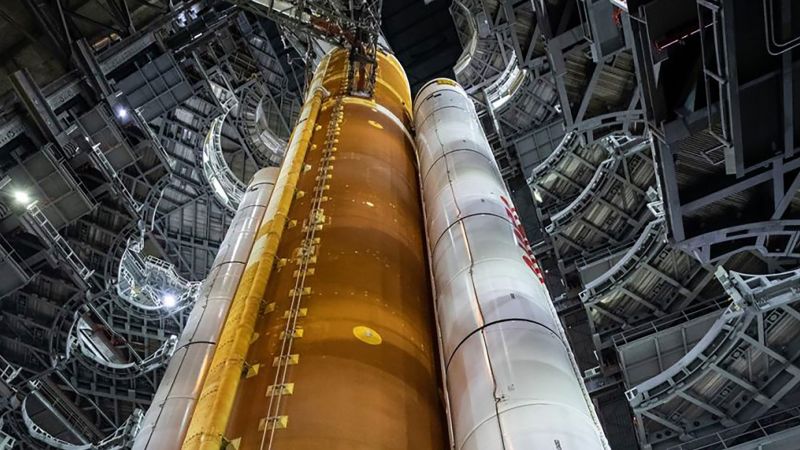The hulking rocket at the heart of NASA’s plans to return humans to the moon is headed back to the launchpad Friday as the space agency gears up for another attempt to get the Artemis I mission off the ground.
Liftoff of the uncrewed test mission is slated for November 14, with a 69-minute launch window that opens at 12:07 a.m. ET. The launch will stream live on NASA’s website.
The Space Launch System, or SLS, rocket began the hours-long process of trekking 4 miles (6.4 kilometers) from its indoor shelter to Pad 39B at NASA’s Kennedy Space Center in Florida late Thursday evening.
The rocket had been stowed away for weeks after issues with fuel leaks that thwarted the first two launch attempts and then a hurricane rolled through Florida, forcing the rocket to vacate the launchpad and head for safety.
The Artemis team again is monitoring a storm that could be heading toward Florida but feels confident to move ahead with rollout to the launchpad, said Jim Free, associate administrator for NASA’s Exploration Systems Development Mission Directorate.
The unnamed storm could develop near Puerto Rico over the weekend and will slowly move northwest early next week, said meteorologist Mark Burger, the launch weather officer with the US Air Force at Cape Canaveral.
“The National Hurricane Center just has a 30% chance of it becoming a named storm,” Burger said. “However, that being said, the models are very consistent on developing some sort of a low pressure.”
Weather officers don’t anticipate it becoming a strong system, but they will watch for potential impacts into the middle of next week, he said.
Returning the 322-foot-tall (98-meter-tall) SLS rocket to the nearby Vehicle Assembly Building, or VAB, gave engineers a chance to take a deeper look at issues that have been plaguing the rocket and to perform maintenance.
In September, NASA raced against the clock to get Artemis I off the ground because there was a risk of draining batteries essential to the mission if it spent too long on the launchpad without liftoff. Engineers were able to recharge or replace batteries throughout the rocket and the Orion spacecraft atop it as they sat in the VAB.
The overall goal of NASA’s Artemis program is to return humans to the moon for the first time in half a century. And the Artemis I mission — expected to be the first of many — will lay the groundwork, testing the rocket and spacecraft and all their subsystems to ensure they are safe enough for astronauts to fly to the moon and back.
But getting this first mission off the ground has been trying. The SLS rocket, which cost roughly $4 billion, ran into problems as it was loaded with super-chilled liquid hydrogen, springing a series of leaks. A faulty sensor also gave inaccurate readings as the rocket attempted to “condition” its engines, a process that cools the engines down so they’re not shocked by the temperatures of its super-chilled fuel.
NASA has worked to troubleshoot both issues. The Artemis team decided to mask the faulty sensor, essentially ignoring the data it puts out. And following the second launch attempt in September, the space agency ran another ground test when the rocket was still on the launchpad.
The purpose of the cryogenic demonstration was to test the seals and use updated “kinder and gentler” loading procedures of the supercold propellant, which is what the rocket would experience on launch day. While the test didn’t go exactly as planned, NASA said it met all its objectives.
NASA officials again emphasized that these delays and technical issues don’t necessarily point to a significant problem with the rocket.
Before the SLS, NASA’s space shuttle program, which flew for 30 years, endured frequent scrubbed launches. SpaceX’s Falcon rockets also have a history of scrubs for mechanical or technical issues.
“I do want to reflect on the fact that this is a challenging mission,” Free said. “We’ve seen challenges just getting all our systems to work together and that’s why we do a flight test. It’s about going after the things that can’t be modeled. And we’re learning by taking more risk on this mission before we put crew on there.”
The Artemis I mission is expected to pave the way for other missions to the moon. After takeoff, the Orion capsule, which is designed to carry astronauts and sits atop the rocket during liftoff, will separate as it reaches space. It’ll fly empty for this mission, apart from a couple of mannequins. The Orion capsule will spend a few days maneuvering out to the moon before entering its orbit and beginning the trek back home days later.
Overall, the mission is expected to last for 25 days, with the Orion capsule’s splashdown in the Pacific Ocean off San Diego set for December 9.
The purpose of the journey is to gather data and test out the hardware, navigation and other systems to ensure both the SLS rocket and Orion capsule are ready to host astronauts. The Artemis program aims to land the first woman and first person of color on the lunar surface this decade.
The Artemis II mission, slated for 2024, is expected to follow a similar flight path around the moon but will have crew on board. And in 2025, Artemis III is expected to land astronauts on the lunar surface for the first time since NASA’s Apollo program.
This content should not be accepted as official or professional advice.












